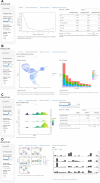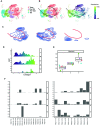LRT: Integrative analysis of scRNA-seq and scTCR-seq data to investigate clonal differentiation heterogeneity
- PMID: 37428794
- PMCID: PMC10358952
- DOI: 10.1371/journal.pcbi.1011300
LRT: Integrative analysis of scRNA-seq and scTCR-seq data to investigate clonal differentiation heterogeneity
Abstract
Single-cell RNA sequencing (scRNA-seq) data has been widely used for cell trajectory inference, with the assumption that cells with similar expression profiles share the same differentiation state. However, the inferred trajectory may not reveal clonal differentiation heterogeneity among T cell clones. Single-cell T cell receptor sequencing (scTCR-seq) data provides invaluable insights into the clonal relationship among cells, yet it lacks functional characteristics. Therefore, scRNA-seq and scTCR-seq data complement each other in improving trajectory inference, where a reliable computational tool is still missing. We developed LRT, a computational framework for the integrative analysis of scTCR-seq and scRNA-seq data to explore clonal differentiation trajectory heterogeneity. Specifically, LRT uses the transcriptomics information from scRNA-seq data to construct overall cell trajectories and then utilizes both the TCR sequence information and phenotype information to identify clonotype clusters with distinct differentiation biasedness. LRT provides a comprehensive analysis workflow, including preprocessing, cell trajectory inference, clonotype clustering, trajectory biasedness evaluation, and clonotype cluster characterization. We illustrated its utility using scRNA-seq and scTCR-seq data of CD8+ T cells and CD4+ T cells with acute lymphocytic choriomeningitis virus infection. These analyses identified several clonotype clusters with distinct skewed distribution along the differentiation path, which cannot be revealed solely based on scRNA-seq data. Clones from different clonotype clusters exhibited diverse expansion capability, V-J gene usage pattern and CDR3 motifs. The LRT framework was implemented as an R package 'LRT', and it is now publicly accessible at https://github.com/JuanXie19/LRT. In addition, it provides two Shiny apps 'shinyClone' and 'shinyClust' that allow users to interactively explore distributions of clonotypes, conduct repertoire analysis, implement clustering of clonotypes, trajectory biasedness evaluation, and clonotype cluster characterization.
Copyright: © 2023 Xie et al. This is an open access article distributed under the terms of the Creative Commons Attribution License, which permits unrestricted use, distribution, and reproduction in any medium, provided the original author and source are credited.
Conflict of interest statement
The authors have declared that no competing interests exist.
Figures






Similar articles
-
T Cell Clonal Analysis Using Single-cell RNA Sequencing and Reference Maps.Bio Protoc. 2023 Aug 20;13(16):e4735. doi: 10.21769/BioProtoc.4735. eCollection 2023 Aug 20. Bio Protoc. 2023. PMID: 37638293 Free PMC article.
-
Immunopipe: a comprehensive and flexible scRNA-seq and scTCR-seq data analysis pipeline.NAR Genom Bioinform. 2025 May 19;7(2):lqaf063. doi: 10.1093/nargab/lqaf063. eCollection 2025 Jun. NAR Genom Bioinform. 2025. PMID: 40391086 Free PMC article.
-
Repertoire-based mapping and time-tracking of T helper cell subsets in scRNA-Seq.Front Immunol. 2025 Apr 4;16:1536302. doi: 10.3389/fimmu.2025.1536302. eCollection 2025. Front Immunol. 2025. PMID: 40255395 Free PMC article.
-
Practical Compass of Single-Cell RNA-Seq Analysis.Curr Osteoporos Rep. 2024 Oct;22(5):433-440. doi: 10.1007/s11914-023-00840-4. Epub 2023 Nov 29. Curr Osteoporos Rep. 2024. PMID: 38019344 Free PMC article. Review.
-
Machine learning and statistical methods for clustering single-cell RNA-sequencing data.Brief Bioinform. 2020 Jul 15;21(4):1209-1223. doi: 10.1093/bib/bbz063. Brief Bioinform. 2020. PMID: 31243426 Review.
Cited by
-
A Novel Missense Variant in SORBS2 Is Causative With Familial Alzheimer's Disease.CNS Neurosci Ther. 2025 Feb;31(2):e70256. doi: 10.1111/cns.70256. CNS Neurosci Ther. 2025. PMID: 39912518 Free PMC article.
-
Identifying T-cell clubs by embracing the local harmony between TCR and gene expressions.Mol Syst Biol. 2024 Dec;20(12):1329-1345. doi: 10.1038/s44320-024-00070-5. Epub 2024 Nov 4. Mol Syst Biol. 2024. PMID: 39496799 Free PMC article.
-
Measuring single-cell immune clonality to track haematological cancers.Clin Transl Med. 2024 Aug;14(8):e1780. doi: 10.1002/ctm2.1780. Clin Transl Med. 2024. PMID: 39162183 Free PMC article.
References
Publication types
MeSH terms
Substances
Grants and funding
LinkOut - more resources
Full Text Sources
Research Materials

